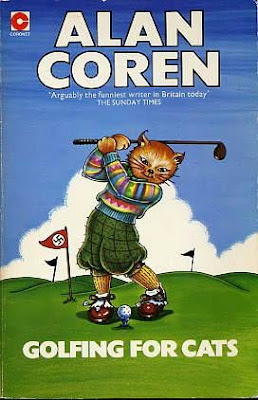Scroll through your feed – LinkedIn, Reddit, Bluesky, wherever you get your updates. It's relentless, isn't it? The constant stream of articles, posts, threads, all vying for attention, often tailored to whatever your algorithm thinks will hold your gaze. And behind that stream, you can almost sense the engine driving it: an ever-present hum, a pressure to post consistently, stay visible, feed the hungry algorithms.
But look closer. How much of it feels truly substantial versus... optimized? How often do you see the same ideas rehashed, the same formats repeated? Content that seems engineered less for genuine insight and more for that quick hit of likes, shares, and shallow engagement. It increasingly feels like the quality is secondary to the quota.
This whole situation reminds me of the brilliant work and cynical wit of the late British humourist Alan Coren. He actually published a book titled "Golfing for Cats" back in 1975. The anecdote, perhaps embellished over time, suggests he deliberately combined unrelated but guaranteed attention-grabbing elements—like cats, golf, and even controversial symbols like Nazis—to satirize the publishing world’s cynicism. In fact, the book itself contained no stories about golf, cats, or Nazis at all; the title was purely a witty critique about what publishers believed would sell.

Updating the Formula for 2025
Coren's formula – mashing up unrelated elements known to grab eyeballs – is timeless. So what does "Golfing for Cats" look like in 2025? The specific ingredients change, but the recipe remains. In today’s digital ecosystem, where trends shift at lightning speed, today's zeitgeist, combined with the eternal truths of internet engagement, might suggest this potent attention-grabbing triad:
- AI & Generative Technology: Covering everything from AI-generated art and deepfakes to ChatGPT's latest capabilities, autonomous agents, and virtual influencers.
- Cats: Because, let's be honest, the foundational layer of the internet might as well be built on pet pictures, videos and memes! Their appeal is universal, evergreen, and a guaranteed engagement baseline. It's the modern echo of Coren's original insight.
- Billionaire & Influencer Culture: Focusing on tech mogul antics, influencer scandals, the creator economy's realities, wealth disparity discourse, and the mechanics of social media fame.
Following Coren’s mischievous logic, the 2025 guaranteed-attention piece, cynically engineered for maximum clicks by combining the cutting edge with the eternally popular and the currently controversial, might be titled something like:

Does it represent a deep, coherent insight?
- Almost certainly not.
Does it smash together the hottest tech trend, a perennially beloved internet staple, and a topic of intense cultural fascination or outrage?
- Absolutely.
It perfectly exemplifies the strategy: combining trending, emotionally charged, or simply popular themes purely to maximize reach and reaction, utterly divorced from any need for real substance.
Why This Happens: The Business Case for Content Churn
This isn't just random noise; it's often a calculated response to the online environment. The incentives frequently reward volume and specific engagement patterns:
The Algorithmic Treadmill: Platform algorithms (both search and social) often favor recency, frequency, and easily measurable engagement signals. Research indicates that consistent posting can boost visibility significantly in some cases.
Attention Arbitrage: In a crowded space, shortcuts emerge. We see the patterns constantly, optimized for clicks and shares:
- The Bold, Existential Business Threat: "In 2025, If your Saas can be replaced by a prompt, It's Not a Business." (Creates urgency and fear).
- The Geographic Outrage Bait: "Singapore will jail you for 15 years for using this chemical. America puts it in your breakfast. Not even joking." (Triggers disbelief and anger).
- The Counter-Intuitive Viral Human Story: "The co-founder of Loom sold his biz for ~$1B, made $50-70M personally, then walked away from an extra $60M. He has 'no income right now' and is 'looking for internships'..." (Sparks curiosity, debate, and relatability/disbelief).
- The Negative Framing Advantage: "The 5 Worst Mistakes You're Making With [Hot Topic] Right Now" (Leverages fear of missing out (FOMO) and loss aversion; negativity reportedly boosts clicks significantly compared to positive framing like "Best Practices").
These structures aren't accidental; they are often highly refined formats designed to hook attention and exploit cognitive biases, driving engagement metrics even if the substance is thin.
The Quality vs. Quantity Dilemma & My Stance
This environment creates a significant challenge. If the algorithms preferentially amplify content optimized for engagement over depth, how do genuinely insightful pieces even find an audience without playing the same game? It’s a frustrating question without an easy answer.
It also leads to the slightly self-aware pause: Is this very post, dissecting these tactics and using the "AI-Generated Kittens for Billionaire Influencers" gag, just another example of the same phenomenon? Maybe. Critiquing the state of online content is a reliable topic.
But the goal here isn't just to point fingers. It's a reflection on value. Does chasing engagement via these formulas build lasting trust or just fleeting attention? Does it contribute meaningful signal or just add to the deafening noise?
My commitment on this blog is this: No fixed schedules. No posting quotas. The urge to "just post something" to stay visible will be consciously ignored.
I still believe the best time to publish is when you genuinely feel you have something non-obvious, insightful, or uniquely valuable to share – something that required more effort than simply combining trending topics or following a clickbait template. Building an audience that values signal over noise demands a commitment to signal, even if it means periods of silence.